Overview
Commercial real estate (CRE) stands out as a robust investment opportunity, primarily due to its potential for steady cash flow, appreciation, and tax advantages. The increasing demand in sectors such as industrial and logistics properties further underscores its appeal. Current market trends illustrate the resilience of the CRE sector, even in the face of challenges, highlighting the significant benefits that long-term lease agreements and favorable economic conditions provide to investors.
Investors should take note of the compelling data supporting these insights. For instance, the ongoing growth in logistics and industrial properties reflects a broader shift in market dynamics, driven by e-commerce and supply chain demands. This trend not only enhances the desirability of CRE but also positions it as a strategic asset in a diversified portfolio.
In conclusion, as you evaluate your investment strategies, consider the implications of these trends within the CRE market. The potential for consistent returns, combined with the advantages of long-term leases and favorable economic conditions, makes commercial real estate an attractive option for savvy investors.
Introduction
Commercial real estate (CRE) represents a dynamic sector that encompasses a wide range of properties designed for business purposes, including office buildings, retail spaces, and industrial warehouses. As the landscape continues to evolve, grasping the intricacies of CRE is essential for investors aiming to navigate its complexities and seize lucrative opportunities.
With a significant portion of wealth attributed to real estate investments, the potential for financial growth in this arena is substantial. However, the market is not without challenges, such as fluctuating interest rates and changing consumer behaviors.
This article explores the following:
- Various types of commercial real estate
- Current market trends
- Importance of location
- Associated risks and benefits
Providing a comprehensive guide for those looking to invest wisely in this thriving industry.
Defining Commercial Real Estate: An Overview
Commercial physical assets (CRE) encompass spaces designated exclusively for business activities, distinguishing them from residential properties, which serve as living quarters. CRE includes a wide range of property types that generate income through leasing or selling, such as office buildings, retail spaces, industrial warehouses, and multifamily housing units. Understanding the essence of business property is crucial for investors aiming to navigate this field effectively, as it forms the foundation for evaluating various categories and investment opportunities.
As we approach 2025, the landscape of business property continues to evolve, with experts emphasizing the importance of understanding market dynamics and trends. This comprehension is vital for making informed investment decisions in a sector that remains a cornerstone of wealth creation, as evidenced by the statistic that 90% of millionaires attribute their wealth to property investments.
The commercial property market has demonstrated resilience in the face of challenges. For example, while retail foot traffic has declined by 12% year-over-year, the sector has still managed to achieve a growth rate of 3.2%. This shift in consumer behavior underscores the necessity of adaptability in investment strategies.
Current statistics indicate that cap rates for multifamily properties average approximately 4.2% nationwide, with institutional investors owning over 17% of rental properties in major cities. This trend highlights the increasing interest in multifamily investments as a dependable income source and underscores the significance of institutional participation in the market.
A notable case study is the surging demand for industrial and logistics properties in Europe, driven by the rise in online retail sales. Over the past fifteen years, all Nordic countries have witnessed steady growth in e-commerce, with expectations for continued expansion. In 2021, the UK led in investment value within this sector, while Sweden ranked fifth in Europe for industrial and logistics investment, with investments totaling 4.3 billion EUR.
Moreover, industrial and logistics investments in Norway reached 1.8 billion EUR, further illustrating the robust growth in this sector. Together, these insights emphasize the emerging opportunities within commercial property, prompting the question: Is commercial real estate a sound investment for those looking to capitalize on market trends?
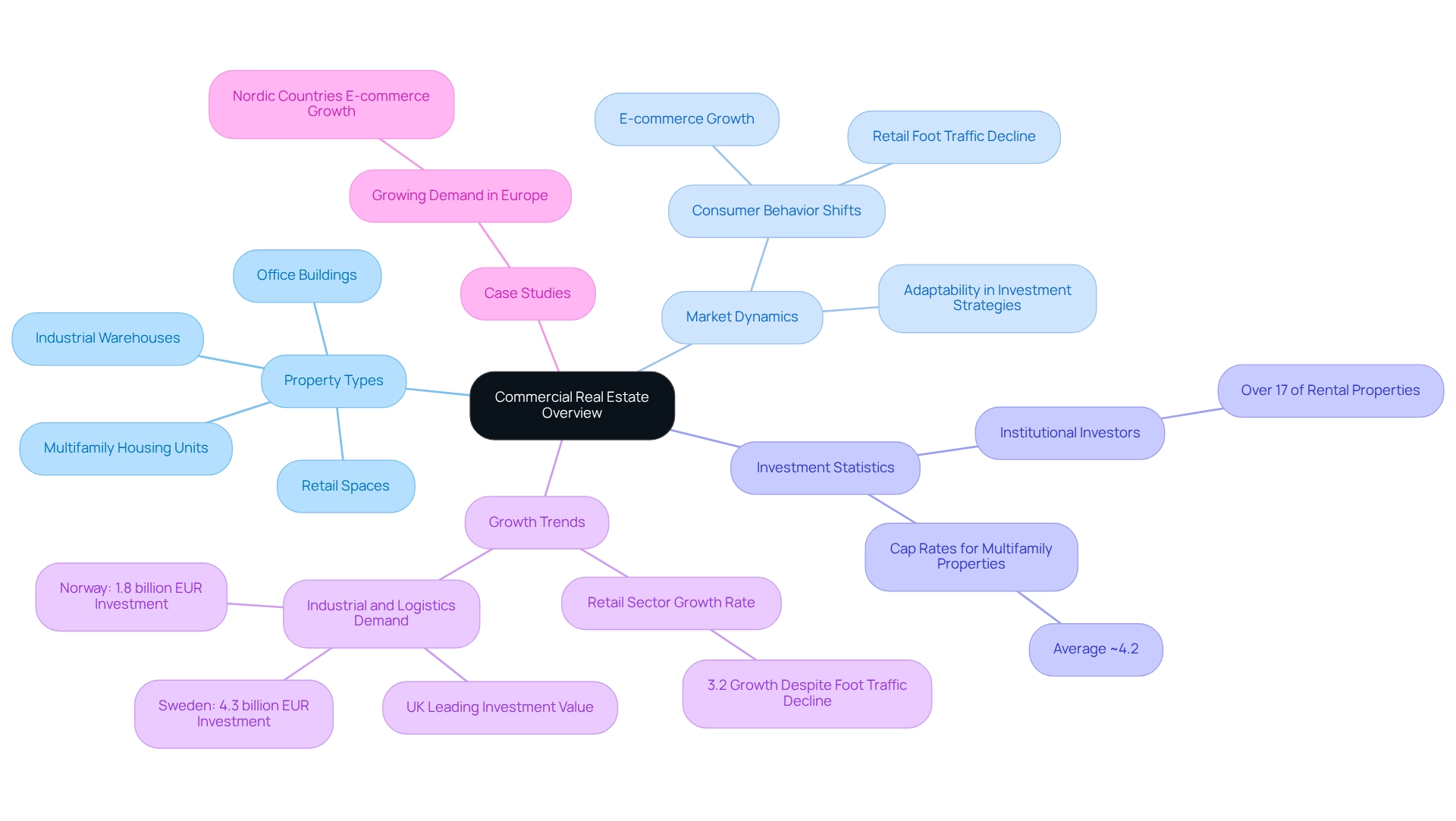
Exploring the Different Types of Commercial Real Estate
Commercial real estate encompasses a variety of categories, each tailored to specific functions and investment strategies. The primary types include:
-
Office Buildings: Designed for business operations, these assets can range from single-tenant offices to expansive skyscrapers, catering to diverse corporate needs. Recent insights indicate that suburban office markets are stabilizing, with some areas showing signs of cap rate flatness or declines, as noted by Victor Calanog, Global Head of Research and Strategy at Manulife Investment Management.
-
Retail Spaces: This category includes shopping centers, strip malls, and standalone stores, all aimed at serving consumer demands and enhancing shopping experiences. A survey of commercial REALTORS® highlighted the building features that are most important to their clients, reflecting current market preferences.
-
Industrial Sites: Utilized for manufacturing, warehousing, and distribution, these locations are typically situated in designated industrial zones, reflecting the growing demand for logistics and supply chain efficiency.
-
Multifamily Housing: Comprising apartment complexes and similar structures, these assets offer residential units for multiple families, addressing the ongoing housing needs in urban areas.
-
Hospitality: This sector includes hotels and motels, which offer lodging services and are influenced by tourism trends and local economic conditions.
-
Mixed-Use Developments: These innovative sites integrate residential, business, and occasionally industrial spaces, fostering vibrant communities and optimizing land use.
Understanding Special Purpose properties, such as schools, churches, or self-storage facilities, which cater to niche markets, can help investors determine if commercial real estate is a good investment by tailoring their strategies to align with the specific characteristics and market demands of each type, ultimately enhancing their investment outcomes. For example, the produced revenue of Colliers International reached $4.42 billion in June 2023, suggesting a strong financial environment in property.
Furthermore, cities such as Nashville and Dallas are rising as appealing markets for investment, while established centers like San Francisco and New York encounter considerable difficulties, highlighting the significance of localized market evaluation in property investment. Moreover, the incorporation of AI in property is simplifying decision-making procedures, allowing for predictive forecasting and effective data analysis, which can greatly influence investment strategies.
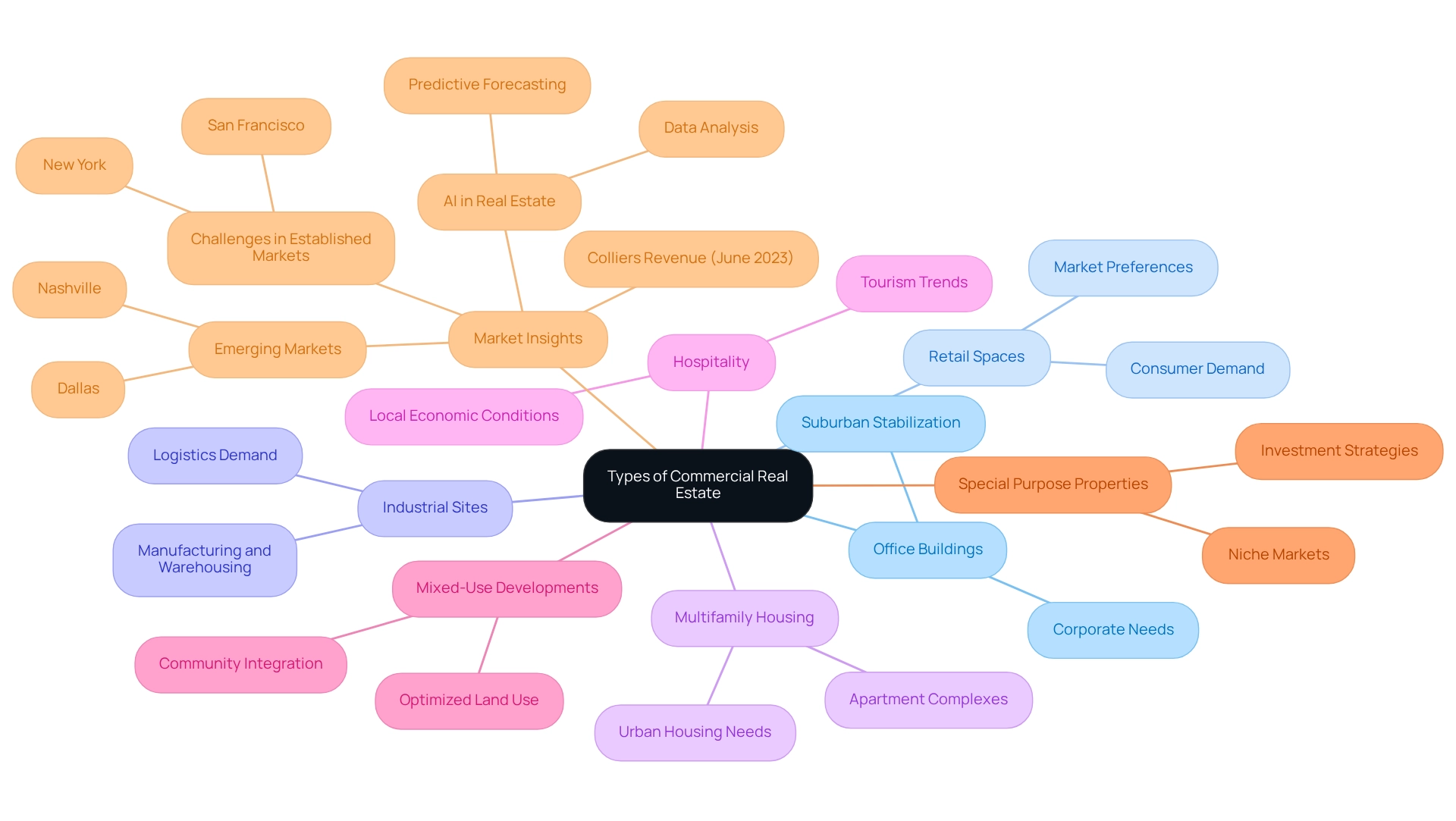
Current Market Trends: The Impact of Declining Interest Rates
In recent years, the question of whether commercial real estate is a good investment has been notably shaped by declining interest rates. These reduced borrowing expenses have made funding more attainable, leading to a rise in real estate acquisitions and developments. As interest rates decline, the cost of capital becomes more advantageous. This raises the question: is commercial real estate a good investment? The increase in asset valuations and the potential for higher returns certainly suggest it could be.
This trend is especially important in 2025, as the market displays signs of hope despite prior stagnation, suggesting that a surge in business property transactions may be forthcoming. Reduced interest rates typically encourage demand for business real estate, prompting further inquiry into whether commercial real estate is a good investment. Companies are more likely to grow or relocate in a more advantageous economic environment. Current market news indicates that while the Federal Reserve is navigating a delicate economic situation characterized by potential stagnation, careful decision-making reflects an awareness of these challenges, yet optimism persists.
Investors should remain vigilant in monitoring interest rate trends. Understanding whether commercial real estate is a good investment is often influenced by these rates, which are pivotal in shaping market dynamics and investment opportunities. Statistics suggest a connection between property acquisition activity and interest rates, highlighting the significance of comprehending how these financial elements affect the business realty landscape. This understanding is particularly crucial when evaluating if commercial real estate is a good investment. Additionally, case studies reveal that organizations are adapting to attract the next generation of workforce talent, aligning with values such as climate action and technological advancement, which further impacts investment strategies in the sector.
As Victor Calanog, Global Head of Research and Strategy at Manulife Investment Management, observes, 'Good retail in prime locations is likely to perform well, despite ongoing growth of the e-commerce segment.' This emphasizes the subtle opportunities within the property market. With over 30,000 subscribers, Zero Flux provides credible insights that reflect these evolving trends, making it a vital resource for investors navigating this dynamic landscape.
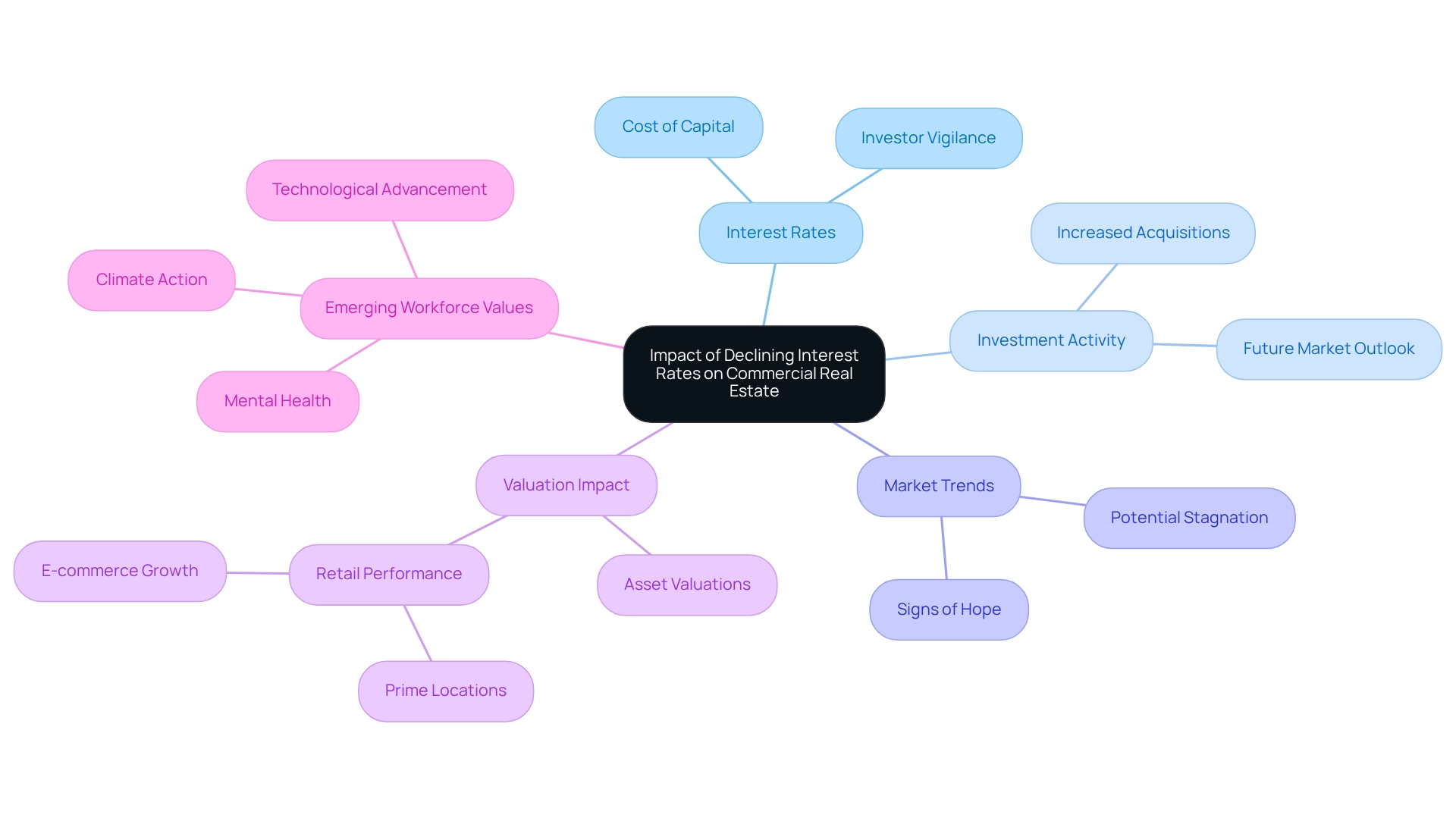
Why Invest? Key Benefits of Commercial Real Estate
Investing in business real estate presents a multitude of benefits that can significantly enhance an investor's portfolio.
-
Steady Cash Flow: Many investors ponder whether commercial real estate is a sound investment, given its reputation for generating reliable rental income. This income is often supported by long-term lease agreements, which are typically more stable than those found in residential markets. Such stability can deliver a predictable revenue stream for investors.
-
Potential for Appreciation: Over time, business assets may appreciate in value, enabling investors to realize substantial capital gains upon sale. Current trends indicate that specific markets, such as Austin and Dallas, are experiencing noteworthy growth, with CBRE identifying these cities as leading areas for property expansion. Furthermore, the increasing demand for industrial properties is highlighted by significant e-commerce sales, which reached $308.9 billion in the fourth quarter of 2024, reflecting a 9.4% year-over-year growth.
-
Tax Advantages: Investors can leverage various tax deductions, including depreciation and mortgage interest, which can considerably enhance overall returns. These advantages make business property an attractive option for tax-conscious investors contemplating whether commercial real estate is a viable investment. Incorporating commercial property into an investment portfolio raises the question of its viability, as it can mitigate risk through asset diversification. This strategy is particularly advantageous in volatile markets, as it helps stabilize overall portfolio performance.
-
Inflation Protection: Commercial property often serves as a hedge against inflation. As inflation rises, so do rental incomes and asset values, thereby preserving investors' purchasing power.
-
Professional Relationships: Engaging in business property activities fosters significant networking opportunities with fellow investors, brokers, and industry experts. These connections can lead to additional investment prospects and insights into market trends.
The benefits of investing in business properties are underscored by recent data, such as the 9.4% year-over-year increase in e-commerce sales, which highlights the growing demand for industrial locations to support online retail. This trend not only reflects a robust retail environment but also signals a promising outlook for property investments. Moreover, it is essential to consider the evolving competitive landscape of the U.S. property sector, as major companies report varying revenues and market valuations, which could influence investment strategies.
As the market continues to evolve, many investors question whether commercial real estate is a prudent investment, given that the advantages of investing in it remain compelling for those seeking to build wealth and achieve financial stability.
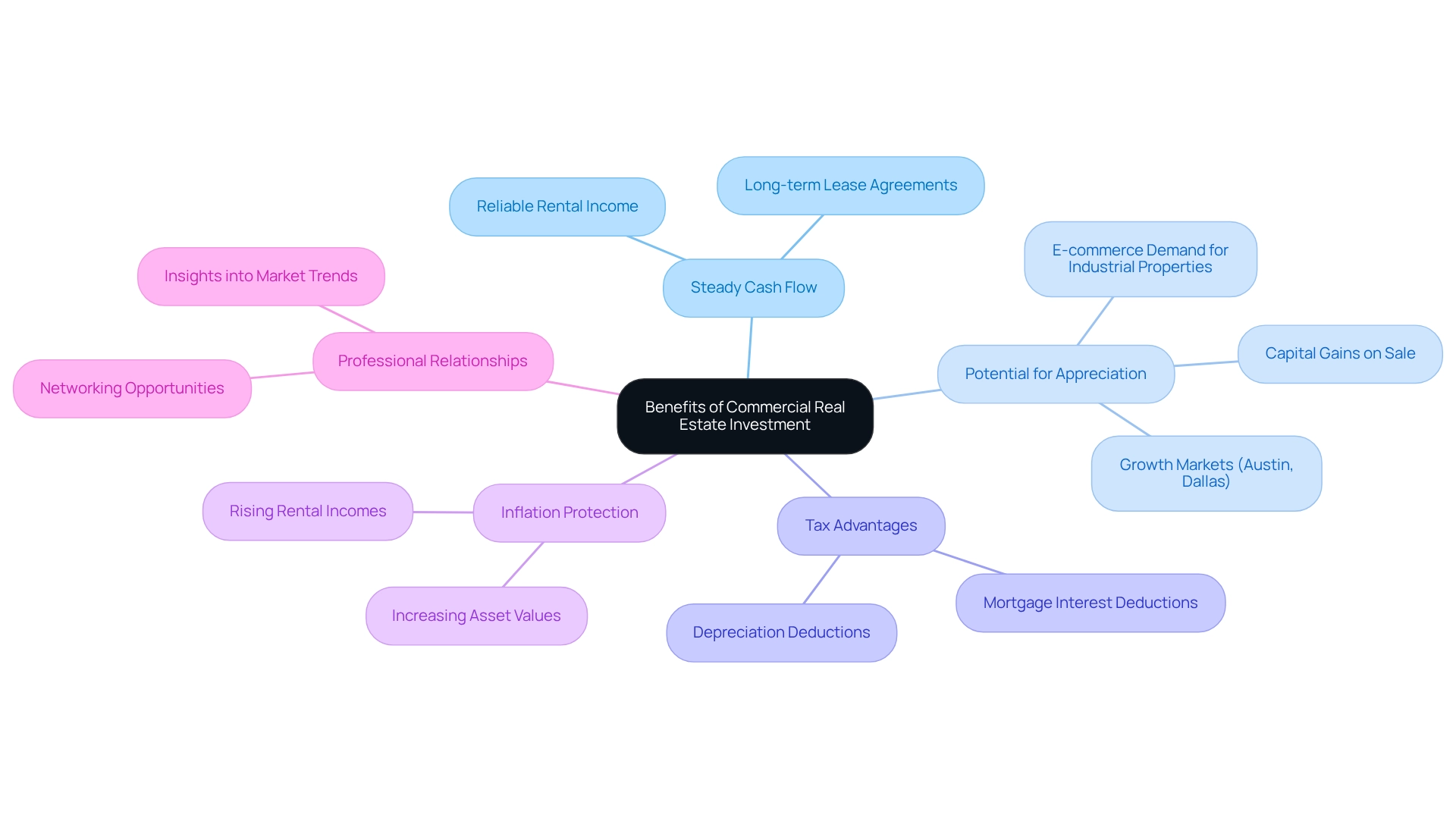
The Crucial Role of Location in Investment Success
Location plays a pivotal role in determining the success of commercial real estate investments. Properties situated in prime locations typically witness heightened demand, which leads to increased rental income and appreciation in asset values. Key considerations include:
- Accessibility: Proximity to major transportation routes and public transit significantly enhances a property's appeal to both tenants and customers, facilitating ease of access.
- Demographics: A comprehensive understanding of the local population's characteristics—such as income levels and age distribution—enables investors to identify the most suitable types of real estate for the area, aligning with market demands.
- Economic Growth: Regions experiencing robust economic expansion and employment growth tend to attract businesses and residents, thereby increasing the demand for commercial properties. As industry expert Colby Annett states, "Economic growth and strong employment rates are key factors in successful business property investments."
- Visibility: Properties located in high-traffic areas benefit from enhanced visibility, which can drive customer engagement and ultimately increase sales.
Investors are urged to conduct thorough location analyses, including researching local comprehensive plans and demographic projections, to assess whether commercial real estate is a viable investment option. Understanding how these factors influence local market dynamics can lead to more informed investment decisions. Additionally, examining property comparables (comps) allows investors to evaluate market value and investment potential efficiently, shaped by local competition and market dynamics.
By prioritizing location, investors can strategically position their assets for success in the competitive landscape of commercial real estate.
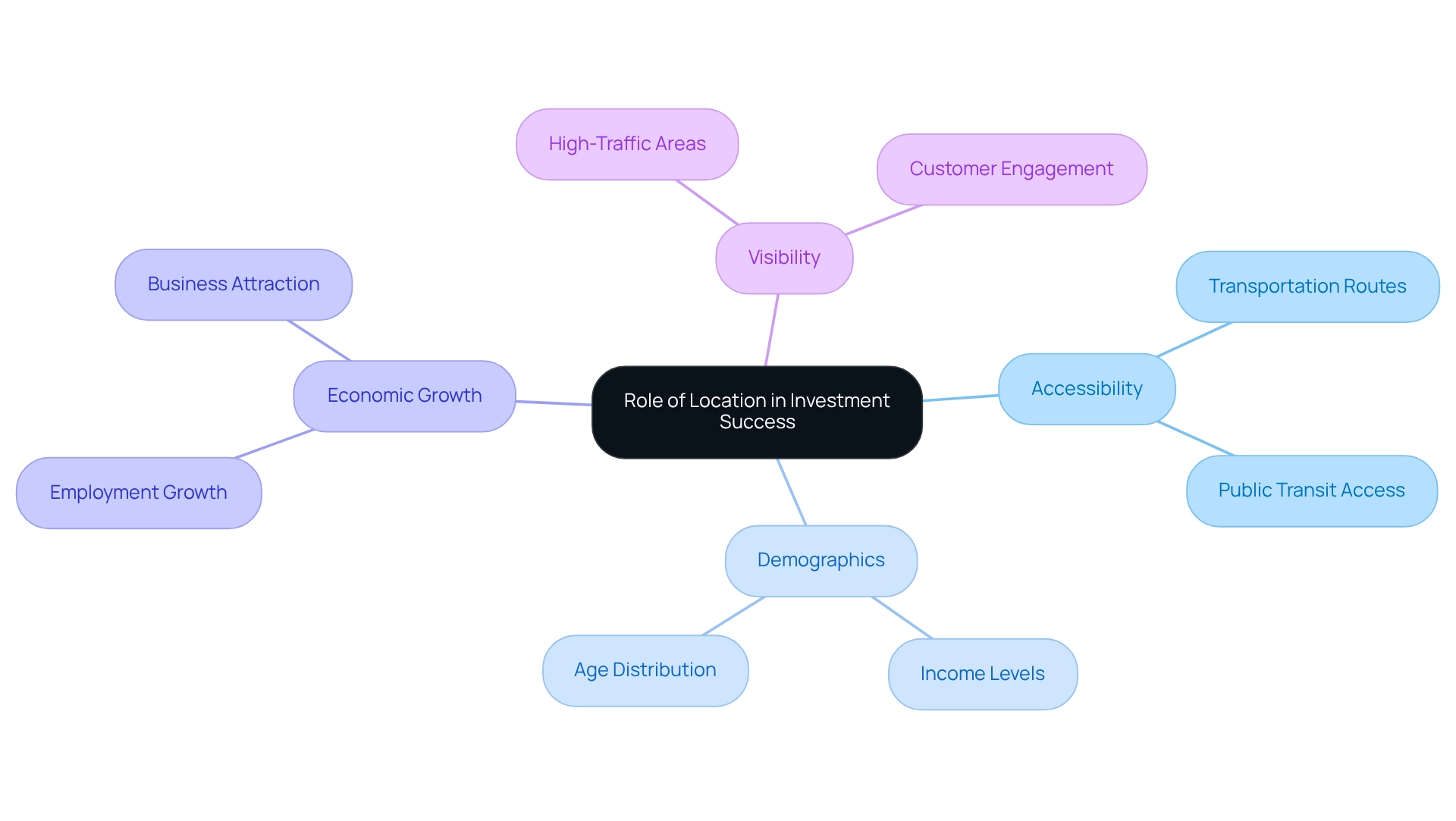
Understanding the Risks: Pros and Cons of Commercial Real Estate
When considering whether commercial real estate is a good investment, it is crucial to recognize that investing in business real estate offers a variety of profitable opportunities but also carries inherent risks that investors must manage. Key risks include:
- Market Volatility: Economic fluctuations can lead to significant changes in demand for business real estate, which in turn affects rental income and asset valuations. Recent trends indicate that investment in retail assets has decreased by $44 billion, while multifamily developments experienced a decline of $76 billion, highlighting the current volatility in the market.
- Liquidity Risk: Unlike residential assets, business real estate frequently necessitates a longer duration to sell, which can create difficulties for investors requiring swift access to cash. The typical duration to sell business assets can prolong considerably, rendering liquidity an essential factor.
- Tenant Risk: The financial prosperity of a business site heavily depends on the stability and reliability of its tenants. Vacancies or defaults can severely disrupt cash flow, underscoring the importance of thorough tenant screening and management.
- Regulatory Risks: Changes in zoning laws, real estate taxes, and other regulations can profoundly impact asset values and investment returns. Staying informed about local regulatory environments is essential for mitigating these risks.
- High Upfront Costs: The initial investment needed to acquire business properties is generally considerable, which can dissuade prospective investors. Understanding the financial commitment involved is crucial for effective planning, particularly when evaluating if commercial real estate is a good investment. In light of these risks, it is vital for investors to develop robust strategies to mitigate them.
For instance, the San Francisco multifamily market is currently experiencing a tightening trend, with the lowest vacancy rate since 2019, indicating strong demand. This case demonstrates how focused investments in high-demand sectors can produce favorable results despite wider market difficulties. Furthermore, expert opinions indicate that the property market in the U.S. is expected to expand at a compound annual growth rate (CAGR) surpassing 3.45% by 2028, offering possibilities for long-term benefits.
Additionally, Tracy Hadden Loh, a Fellow at Brookings Metro, noted that the share of 504 loan dollars going to Black business owners increased from 1.43% in 2019 to 2.97% in 2023, highlighting evolving financing opportunities in the sector. By grasping the risks and utilizing effective strategies, investors can navigate the intricacies of property investment and capitalize on its prospects. Furthermore, the market cap of RE/Max at $0.56 billion underscores the competitive landscape investors must consider.

Investment Strategies: How to Succeed in Commercial Real Estate
To excel in real estate investing, adopting a multifaceted approach that encompasses essential strategies is crucial.
-
Conduct Thorough Market Research: A deep understanding of local market conditions, trends, and demographics is vital. This knowledge enables investors to make informed decisions that align with current and future market dynamics.
-
Diversify Your Portfolio: Investing across various types of commercial properties—such as office spaces, retail, and logistics—can significantly mitigate risks and enhance overall returns. A diversified portfolio can better withstand market fluctuations and capitalize on emerging opportunities.
-
Focus on Cash Flow: Prioritizing properties that generate consistent rental income is essential for ensuring financial stability. Properties with strong cash flow provide a reliable income stream, which is particularly important in uncertain economic climates.
-
Utilize Professional Networks: Establishing connections with property agents, brokers, and other investors offers valuable insights and access to off-market opportunities. Networking facilitates partnerships that enhance investment opportunities and knowledge sharing.
-
Stay Informed on Economic Trends: Keeping updated on economic indicators and market movements is essential, as these elements can greatly influence property values and demand. For instance, the current rate of available office space has reached a record high of 16.4%, indicating shifts in market dynamics that investors must navigate.
-
Utilize Financial Metrics: Familiarizing oneself with key financial metrics, such as capitalization rates (cap rates) and net operating income (NOI), is essential for evaluating potential investments effectively. Comprehending these metrics enables investors to assess the profitability and risk linked to various properties.
A recent survey by the Deloitte Center for Financial Services revealed that over 880 C-level executives in significant business property firms emphasized the importance of these strategies, especially in light of expected changes in property fundamentals. As the digital economy continues to evolve, properties related to logistics and warehousing are emerging as top opportunities for investors in the next 12 to 18 months. By implementing these strategies, investors can significantly enhance their chances of success and better understand if commercial real estate is a good investment in the competitive landscape.
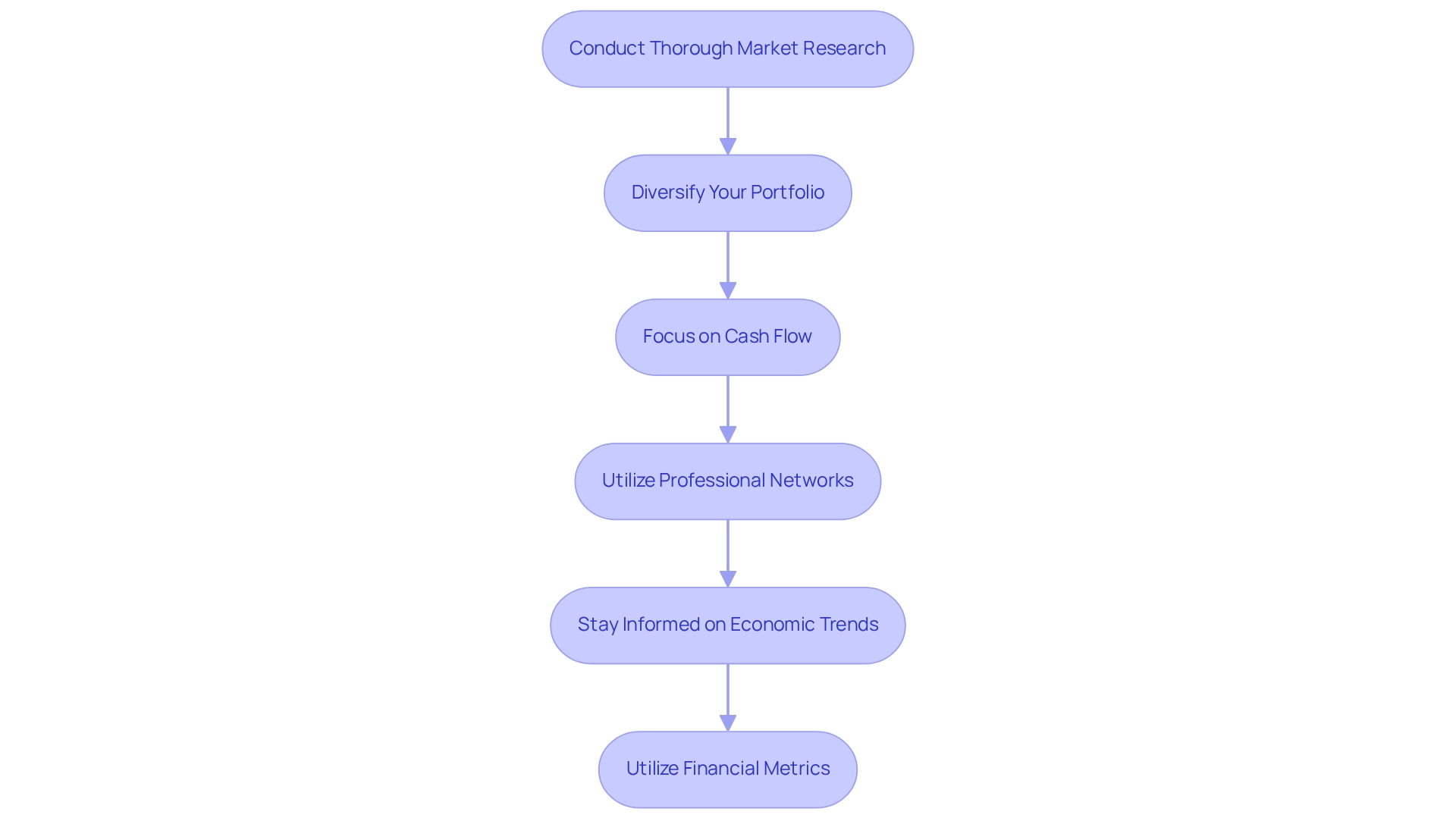
Conclusion
Investing in commercial real estate unveils a realm of opportunities, marked by a diverse array of property types and dynamic market conditions. By grasping the various categories—from office buildings and retail spaces to industrial properties and mixed-use developments—investors can strategically align their approaches with specific market demands. Current trends, including the effects of declining interest rates and the growing significance of location, underscore the necessity for informed decision-making in this sector.
The benefits of commercial real estate investment are substantial, featuring steady cash flow, potential for appreciation, and tax advantages. Yet, investors must remain vigilant about the associated risks, such as market volatility and tenant reliability. By implementing robust investment strategies—like comprehensive market research and portfolio diversification—investors can adeptly navigate these challenges.
Ultimately, the commercial real estate market is in a constant state of evolution, presenting both risks and rewards. Equipped with the right knowledge and strategies, investors can capitalize on the opportunities this dynamic sector presents, positioning themselves for sustained financial growth. As the landscape transforms, remaining informed and adaptable will be crucial for successful investment in commercial real estate.

